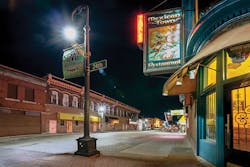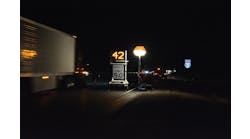The future is looking bright for the city of Detroit, and much of that optimism is due to the recent installation of 65,000 modern, efficient and reliable light-emitting diode (LED) streetlight fixtures that are casting the Motor City in a new light.
“I can remember a few years ago driving down Michigan Avenue early in the morning, and it was complete darkness,” said Edwin Tatem, principal-in-charge for WSP USA, which served as the owner’s engineer for the project. “Detroit had block after block of darkened city streets, lined by rows of broken streetlights.”
At its worst, 40% of the city’s streetlights were on the blink. Large pockets of under-lit or fully darkened sidewalks and roadways led to increased safety concerns for pedestrians and motorists in many of the city’s neighborhoods, casting a dark shadow over the city’s reputation.
But there was a light at the end of the tunnel. In May 2013, WSP and Transmission Maintenance Construction prepared an asset evaluation for the city’s Public Lighting Department (PLD) to determine if Detroit should continue providing the power and maintaining the utility poles, or if it should consider other options. It was a critical first step toward streetlight replacement.
“We assisted the city to determine if they would stay in the lighting business and evaluated illumination options for Detroit,” Tatem said. “WSP provided recommendations for changes and upgrades that would bring substations and overhead and underground distribution systems up to industry standards for reliability and safety.”
The assessment recommended that Detroit transfer management of the city’s lighting to an independent authority, and provided recommendations for the modernization of the existing equipment. The study laid the groundwork for the creation of the Detroit Public Lighting Authority (PLA).
Crews replaced thousands of yellow-hued high-pressure sodium lights with LED alternatives. Images: College for Creative Studies in Detroit
Remove and replace
The creation of the PLA opened the door for upgrading all of the city’s streetlights. It was no small task—Detroit has roughly 30,750 street blocks covering 2,850 miles of road.
Serving as the lead firm for the PLA and the city of Detroit, WSP was responsible for providing engineering, lighting photometric services, budget analysis, and offering recommendations that would enable the authority to achieve full-level illumination in Detroit that meets the national standards of illumination. The firm also provided design and construction management services for the project.
“We analyzed the existing system to see what would be the best approach for restoring lights in the city,” said Warren Andrews, WSP Quality Assurance/Control Manager for the project. “We gave our clients recommendations for illumination and the anticipated cost.”
The final result was a $185 million project that called for the removal and replacement of 88,000 obsolete streetlights that were rapidly falling into disrepair, subject to repeated vandalism, and often stolen for their copper bases.
“Work crews removed tens of thousands of old high-pressure sodium fixtures and their yellowish light, and replaced them with brighter LED lights that use less energy and give off a whiter, cleaner glow,” Tatem said.
In many areas, the aged infrastructure was more than a half-century old and required a complete reconfiguration of the electrical system, which had been provided by the now defunct Detroit PLD. The city’s entire electrical system had to be reconstructed in order to be fed by the distribution grid provided by DTE Energy.
The criteria used for the lighting plan was formulated from the American National Standard Practice for Roadway Lighting ANSI/IESNA RP-8-2000.
Work was separated into three phases, but the final phase of the project was delayed after the city declared bankruptcy, which cast uncertainty upon when and how the project would be completed. The arrival of a new administration in city hall turned out to be the project’s saving grace.
“In order to mobilize the streetlight project and make sure it moved forward, it was going to need a champion,” Tatem said. “Thankfully, that champion turned out to be Detroit Mayor Mike Duggan. Mayor Duggan and City Planner Maurice Cox have an initiative where they want the city to be a 20-minute community. This means, wherever you live in Detroit, you can walk within 20 minutes for anything. The streetlights were an essential component of that plan.”
“For the Motor City, the 20-minute community concept is revolutionary,” Andrews added. “In the past, the city has always pushed for the automobile. The current administration wants the city to be more walkable, and by having streetlights, it creates a safer, more pleasing environment, particularly for the elderly and the young.”
Detroit city officials have noticed a return to population growth, due in part to the city’s no longer being seen as an unsafe or unprosperous place to live. Image: College for Creative Studies in Detroit
Lighting the way
The final streetlight was installed and lit on Dec. 15, 2016, as part of a public dedication ceremony held more than three years after the project began.
“This project gave the city 100% of its lights in working order,” Tatem said. “This has made the city safer and has enhanced the quality of life for residents in Detroit.”
Today, Detroit is one of a handful of U.S. cities that have completely transitioned to LED public lighting, and has become a model of how LED lighting can illuminate larger areas using fewer lights.
To ensure that the streets stay bright, the lighting fixtures were designed and constructed to deter vandalism and theft. “The new streetlights don’t have copper at their base and they use more overhead wiring instead of underground wiring, which thieves often pulled out and sold,” Tatem said.
Public reaction to the improved lighting has been positive.
“In the past, many residents had the perception that inadequate streetlights suggested that Detroit was a city in decay,” he said. “The lights are seen as a sign that the community is now in a real rebirth and Detroit is re-emerging as a modern city.”
The darkness and empty streets people once saw as they drove through Detroit have been replaced with an active city with its people enjoying a better quality of life.
“The other evening I drove through one of the city parks adjacent to our project and there were kids playing baseball and softball, families were congregating and everyone was having a great time,” Tatem said. “Families were walking along the street and they were comfortable. To see small children playing outside means to me that our city is coming back.”
Public officials also have expressed their pleasure not only with the visually stunning results, but also with the significant energy cost savings. Early indications are that the streetlight initiative is having the desired economic effect on attracting downtown business.
“Detroit has become a destination for many different organizations because of revitalization efforts such as this,” Tatem said. “With the improved lighting, people feel more comfortable walking, bicycling or using transit. Walkable cities lead to new hotels, entertainment venues and greater use of bicycles and transit, and Detroit is proving this to be true. New restaurants are opening downtown, and for the first time in 50 years, we are seeing population growth within the city.”
The construction of Little Caesars Arena, a 20,000-seat venue that will be the new home for the Detroit Red Wings of the National Hockey League and Detroit Pistons of the National Basketball Association, also will benefit from the new streetlights when it opens in September.
“For the first time in over 40 years, a professional basketball team will be playing in downtown Detroit,” Andrews said. “The new arena has also opened the way for more private development, including a residential tower that will bring more residents into the city. All of these revitalization efforts feed into one another, and when people feel more comfortable being outside at night—when they feel safer waiting at the transit station or walking to their homes—the whole city benefits.”
Two years after the city’s exit from bankruptcy, the new streetlights are one of the ways Detroit is reinventing its reputation.
“More and more, other communities around the country have noticed what Detroit has accomplished,” Andrews said. “By having these streetlights, it’s another sign of Detroit’s comeback. A city that used to be dark is now illuminated.”
“The symbol of the city of Detroit’s decay was the streetlights being off,” Tatem said. “Now the symbol of the city of Detroit’s rebirth is the streetlights being on. It is an honor to have played a part in this transformation.”



